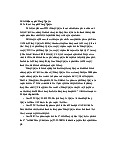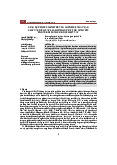








Preview text:
Slide Content number
Send my greetings to you all and to instructor – Mr. Loc
My name is [say your name] and we are group number 3, telling you 1
about one of the most fascinating case studies: Disney's Purchase
Lucasfilm – The Star Wars Negotiations and Trust at the Negotiation Table.
Our group has 5 members, including Quốc Toàn, Minh Dung – the leader, 2
Hùng Minh, Mỹ Dung and Trọng Đại.
And today our presentation includes 4 main parts: introduction, 3
negotiation process, lesson learned, and conclusion.
We focus on three main issues of both Lucasfilm and The Walt Disney Company: 4 Analysis of BATNA Analyze strategies and plans
Drawing lessons and making suggestions
The Walt Disney Company is one of the most famous names in the animation industry. S
ome famous names like Mickey Mouse and Donald
Duck are the foundation of a company that has now reached beyond animation.
From 1923 to 2019, Disney had been established and had several 5 achievements, such as
- opening The Walt Disney World in 1971,
- pointing Robert A. Iger as the CEO in 2005, - buying Pixar in 2006 and
- in 2019, acquiescing 20th Century Fox in March, and then the
remarkable launch of Disney+ in November.
Some information about Robert A. Iger – one of the negotiators,
representative of The Walt Disney Company.
- In 2005, he becomes Disney CEO, facilitates purchase of Pixar and 6 Marvel
- Prior to 2005, he spent 15 years at ABC, became network president in 1984
- Personally negotiated Pixar deal with its CEO, Steve Jobs
Lucasfilm Ltd. LLC is an American film and television manufacturing
organization. The studio is best recognized for developing and 7
producing the Star Wars and Indiana Jones franchises, in addition to its
leadership in developing computer graphics, sound, and animation for films.
From 1977 to 2019, Lucasfilm had been founded and had numerous achievements, such as
- Constructing Skywalker Ranch in San Francisco’s North Bay in 1977.
- In 1979, The Lucasfilm Computer Graphics Division is established at ILM
- Entering a joint venture with The Walt Disney Company in 1987.
- In 1999, Star Wars: The Phantom Menace is the first major live-action
film to be projected digitally.
- And in 2019, receiving a Technical Achievement Award for the ILM HairCraft Dynamics System.
Some information about George Lucas – one of the negotiators, representative of Lucasfilm.
- Chairman and CEO of Lucasfilm and planned to retire in his 60s 8
- Created Star Wars and Indiana Jones franchises
- Founded Lucasfilm, Lucas Arts, and Industrial Light & Magic
Prior to producing films, negotiates ownership of licensing,
merchandising rights, and contractual arrangements for sequels.
From the negotiation, it can be seen that this is a process of building
trust on the negotiating table of both sides.
The Disney Company saw the long-term strategy and planned the acquisition arrangement.
Lucas wants his "brainchild" to be valued at the same price as Pixar - with
over $ 7 billion, while Iger only offers a price of less than $ 4 billion.
On October 30, 2013, Robert A. Iger took a big step into the fantasy 9
world by acquiring Lucasfilm with George Lucas as its head.
Lucas opted for a half cash/half stock deal. Technically, the deal was 55% cash/45% stock: $2.21 billion in cash 37,076,679 shares of Disney
Lucasfilm also gave Disney the franchise rights to Indiana Jones and
Industrial Light and Magic, Lucas' special effects company.
Let’s get to the second also the main part of our presentation – The Negotiation Process.
We must know the objectives of 2 sides: According to Disney 10
Walt Disney's acquisition of Lucasfilm is considered as a fusion of
Hollywood, technology, and gaming, as well as a demonstration of Walt
Disney's interest in technology. According to Lucasfilm
The goal Lucas wants to achieve is to protect his Star War brand and
wanted the episodes of Star Wars to be extended even farther in the
future. Lucas has constructed a highly successful galaxy stories, and he wants to make more.
Now, let’s get to some tactics related to Interests, power, and rights About Disney Power
Disney's growth was even stronger and stronger after acquiring Pixar
and Marvel. The Avengers, grossed $1.5 billion and the Cars Land part
grossed $1 billion in ticket sales worldwide.
“We proved with our Pixar and Marvel acquisitions that we know how
to expand the value of a brand,” Iger said in an interview. “And brands
do not get much bigger than Star Wars.” 11
Disney CEO Robert Iger carried out negotiations by himself in this transaction. Interests
The underlying interests Disney hopes to acquire Star Wars and gain
creative control of the franchise to become expand its brand and remain
the world's leader in the entertainment industry. Rights
Iger expressed the view that Disney will give Lucas the role as a
consultant. In addition, Iger stated that Disney plans to release a new
Star Wars film every two or three years. About Lucasfilm Power
Lucasfilm is more than just making movies and the company also made
computer games with its Lucas Arts division, visual effects technologies
with Industrial Light and Magic, animated movies with Lucasfilm Animation, and more.
Lucasfilm has previously cooperated with Disney's Walt Disney Imagineering division. 12
Kathleen Kennedy, co-chairman of Lucasfilm, is the brand manager for Star Wars in human resources. Interests
For the founder Lucas himself
Lucas, who was in his late 60s, wanted to retire and devote more time
to his family and personal life. Furthermore, Lucas sought to maintain
his influence on Lucasfilm and keep the Star Wars world more expansive. For the prospect of Star Wars
According to the interest analysis, Disney must give significant financial
advantages to Lucasfilm and persuade Lucas that Disney would ensure
that Star Wars maintains its appeal during the negotiating process. The
business transaction is predicted to result in the acquisition's success if these two conditions are met. Rights
The third-party that will appear and testify for this transaction is the
Federal Trade Commission. They authorized the Disney-Lucasfilm
merger, allowing the deal to be completed without having to deal with
antitrust issues. Lucasfilm Ltd.
As the owner of 37 million Disney shares, Lucas will earn $32 million twice
a year as a dividend payment in years when Disney pays dividends (which
has traditionally been every year until 2020).
So, deepening into the process, we will find out how Lucas and Iger
handle each other through the strategies, bargaining process, and 13 BATNA analysis.
About the strategies of Disney, we have 3.
First, strategies to create a sustainable relationship and the purpose is
“To bring satisfaction and trust to partners in the process of contacting
and working to make a deep impression on them.”
“Disney had a long-running relationship with Lucasfilm. In the 1980s,
former Disney CEO Michael Eisner licensed Star Wars and Indiana Jones
to build attractions at their theme parks.”
In May 2011, Iger and Lucas met at the Walt Disney World Hotel in Florida 14
to start a redesigned Star Wars ride. Over a breakfast, Iger asked Lucas,
who later got on the 67th years of life, on the off chance that he could
at any point think about selling his organization. Lucas reacted that he
was willing to talk to Iger about a deal later on, thus, he started the
exchange arranging process for Iger.
Since becoming CEO in 2005, Iger had successes in the procurement of
Pixar Animation Studios and Marvel Entertainment. Another 2 strategies are:
Alternative pricing strategy with the aim “To change the price to match
the value of the product or brand that the opponent brings.”
Iger originally priced Lucasfilm lower than the Marvel brand. After 15
rethinking about brand value, L
ucas did not want to lower his brainchild
compared to other competitors, so Lucas did not want to make a
decision with Iger. With Iger's price-changing strategy and raising the
purchase price of Lucasfilm from $3.75 billion to $4.05 billion, higher than
Marvel brand. That helped Lucas makes the decision to sell Lucasfilm to Iger.
Strategies push to the edge of danger to “To push the opponent towards
a single choice without having a second choice.”
“What finally pushed the deal over the edge was finances. Due to capital
gains changes starting in 2013, Lucas would lose $500 million if he did not
sell by the end of 2012. In the end, Lucas relented, choosing to serve as
a consultant for Disney at Disney’s request, with Disney having no
obligation to use his ideas.” (Aster, 2021)
About the strategies of Lucasfilm, we have 2.
First one is Using Deferment as a Trade-Off, to delay the opponent's
proposal in order to have time to think carefully before making a final decision.
After both sides settled on a price, the difficult negotiating point was
the degree of creative control Lucas had at the new company. Because,
Lucas wanted to keep creative control for his child without any Iger’s
employees interfering. Iger also disagreed with Lucas's agreement.
Therefore, the negotiations continued to be delayed for many months
due to disagreements between the two sides.
Second one is Win – Win situation, there are two main telltale signs for its potential:
The first one is the existence of multiple issues: 16
This negotiation started with a problem: sell Lucasfilm at the highest
price. To looking for potential problems, negotiators may also introduce
other related problems and side agreements for negotiation. For
instance, Lucas wants Disney to keep his employees in the same
positions after the acquisition, while Disney wants to control Lucas’
other varieties: Lucas Art, Industrial Light and Magic, and Skywalker Voice.
The second sign is the two parties' differences in preferences, beliefs, and
capacities across negotiation issues.:
Obviously, Lucas himself is the genius who created Star Wars and his
special properties industry, and Disney has a number of world-class
platforms and markets to create continuous growth. Their different
strengths laid part of the substance for making the big cake.
For further information, we have at least 3 strategies based on Win – Win situation. 17
1: to stand on the other side's point of view. The fact that Iger and Lucas
were brilliant opinion recipients. After successfully acquiring Pixar and
Marvel, Iger required other goals. He knows that Lucas is about to retire
and believes that Star Wars has the ability to create sustained growth.
On the other hand, Lucas knew that Disney was willing and able to
remain his Star Wars tale. When the two sides reached a consensus, the
negotiation went quite smoothly and finally achieved common results.
2: to exchange benefits and primacies by proactively raising such issues
and distributing such information. The exchange of such information
helps the counterparty to understand the worth and show a considerate
attitude. In the negotiation between Disney and Lucas, the issue of who
would have the control over the new Star Wars trilogy played an
important role. It can be inferred that, as the creator of "Star Wars",
Lucas desired to influence the new trilogy, because he had previously
dealt with the storyline during the negotiation. Iger made it plain that
Disney will make the final decision on everything Star Wars-related, but
he pledged that Lucas will have a role in the creation of new Star Wars
films, including the usage of his treatment procedures. This result seems
to be mutually beneficial: Lucas can still influence new movies without
too much pressure from fans, and Disney has a new franchise that
closely matches its expansion plans.
3: to make bundle bargains. Making bundle bargains is the one that
assists with making compromises between issues. As per Jay Rasulo,
Disney's CFO, in spite of the fact that there are various ways Disney will
get esteem from Lucasfilm's licensed innovation, some of which can be
acknowledged quickly while others will accumulate to us over the long
run. Before Disney went into Lucasfilm, stock authorizing income from
Lucasfilm basically came from North America's toy market, however
Disney was positive about bursting them in TV, intuitive media,
amusement parks, live diversion, and buyer items to a top-notch level.
For instance, when the six-disc set of "Star Wars: The Total Adventure,"
was delivered in 2011, it sold $84 million worth of Blu-beams worldwide
in its first seven day stretch of publishing, turning into the most
noteworthy selling Blu-ray list title ever. In this manner, it is additionally
astute for Disney to make bundle manages Lucas.
After having some practical strategies, let me give you their plan and
what their do to gain the objectives. For Disney
Iger rewatched all six Star Wars films prior to the conference and to 18
ensure that Star Wars had enough intellectual property to support additional Star Wars media.
“Disney Company just announced its plans to purchase Lucasfilm Ltd
from George Lucas, with plans to release Star Wars: Episode 7 sometime
during 2015. While there aren't any release dates yet for Episodes 8 and
9, those films will be coming as well — and the studio has even more
beyond a new trilogy planned for the future.” (Ingraham, 2012) And the Disney's BATNA
Even without Lucasfilm, Disney was a very profitable company. They
already had ownership of Pixar and Marvel Studios, which meant they
had command of two massive worlds capable of generating film after
film. Acquiring Lucasfilm fell into Disney's strategy of acquiring multiple
cinematic worlds that provided them with a broad foundation of
characters on which to construct franchises, as they had done before with Pixar and Marvel. For Lucasfilm
Before the negotiation occurred, Lucas positioned Lucasfilm to make
another Star Wars trilogy. He selected Kathleen Kennedy, an
unmistakable Hollywood leader, to head Lucasfilm. Lucas additionally
recruited Michael Arndt, an Oscar winning screenwriter, as a
screenwriter for Scene VII. Lucas was likewise mindful that Disney had
given Pixar artistic liberty, which was also essential to Lucas.
Lucas was already working on a new trilogy and had previously
suggested that there may be many more Star Wars pictures. Disney 19
might possibly develop a Star Wars theme park in the same way that
Universal Orlando did with Harry Potter World. Lucasfilm's BATNA
BATNA at Lucasfilm was to keep doing what they were doing. If the
agreement had fallen through, Lucas would have kept control of the
Star Wars world as well. Lucas Arts would have kept publishing video
games. Essentially, Lucas' BATNA was to keep Lucasfilm running. When
the discussions began, he was 70 years old and wanted to leave Star Wars in capable hands.
So, the end of this negotiation process is about bargaining process. The
purposes of each stage you all may see from the screen. 1st stage is Pre-negotiation 2nd stage Negotiation 3rd stage Specify the goal 20
“The goal is to release Star Wars: Episode 7 in 2015, and "their long-term
plan is to release a new Star Wars movie every two to three years." 4th stage is Agreement
“Under the terms of the agreement and based on the closing price of
Disney stock on October 26, 2012, the transaction value is $4.05 billion,
with Disney paying approximately half of the consideration in cash and
issuing approximately 40 million shares at closing.”
5th stage is Implementation of Agreement
"To justify Disney's $4 billion purchase of Lucasfilm, the company had to
produce new Star Wars pictures on a short schedule, and they had to be blockbusters."
So, for what we may learned from this case is very important. From Lucas
First, do not rush to negotiate and use the time to increase the existing
value of the company. Specifically, appointing Kathleen Kennedy to
head Lucasfilm, hiring Michael Arndt as a screenwriter, and successfully
publishing ideas for a new movie.
Second, the "master yourself, master the enemy" thing to do is not only
to thoroughly understand the parties sitting at the negotiating table, but
also to understand your own resources to avoid unworthy misunderstandings. From Iger
On the Disney side, in addition to understanding themselves and the 21
other party, it is the stories about beliefs and credibility that need to be emphasized.
What Iger possessed was Lucas's belief from the days before the
negotiations, which underpinned the success of this deal. From the
previous extremely successful collaborations of the two studios, as well
as the status, talent and achievements of Iger, he deserves the praise from Lucas.
In addition, the credibility that Iger possesses is through three things: he
fulfills his commitments, he maintains a good partnership, and he has an
attitude of respect for the opinions of the other party.
At the same time, success comes to those who know how to seize
opportunities, and Iger is the one who looks for "golden" times to negotiate.
Although this negotiation was a great success, the negotiation time was
up to 18 months. We suggest solutions to shorten this period of time:
+ Lucas should limit comparing his "brainchild" with other competitors
(e.g., Marvel or Pixar) so as not to repeatedly adjust the selling price. 22
Each company has different strengths and weaknesses, comparisons
will sometimes lead to misconceptions, even demeaning yourself.
+ Iger should create trust and closer relationship with Lucas, trust needs
to be strengthened and decisions will be made faster.
+ The two sides should reduce to one purchased sale unit so that the
procedures are more convenient, all-in cash or all in stocks.
Now, in the conclusion we concluded:
The negotiation was very successful. Both sides also understand the
essentials that both sides can help each other. Each side has its own 23
reasons, based on the negotiation both sides also clarified the issue and
led to successful results. When Disney will also continue to produce Star
Wars parts. Bring Star War to more viewers and save the world for Lucas.
Disney will also expand its market and bring fame and revenue to Disney.
For more information, please capture these resources, these are also our references. 24 Thank you. Any questions so far?



